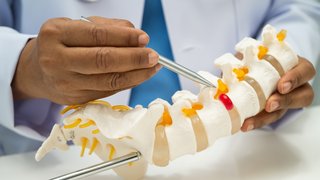How shockwave therapy helps heal sports and overuse injuries
August 4, 2022

“This is like a deep tissue massage.” “It feels like a little jackhammer.” “It hurts so good!”
The list of ways patients describe extracorporeal shockwave therapy (ESWT) is almost as long as the list of conditions this advanced treatment can help heal.
ESWT is an advanced treatment that uses acoustic shockwaves to break up soft tissue calcifications, enhance collagen synthesis, release growth factors, and stimulate your body’s healing process to improve pain and help you stay active.
This therapy enhances blood circulation and accelerates the healing of stubborn musculoskeletal conditions in bones, tendons, ligaments, and muscle.
Depending on the injury, patients can avoid invasive treatments such as steroid injections or surgery. ESWT requires no incisions or downtime. Most patients see long-term results after only three treatments, which take about 15 minutes each.
Using ESWT, the sports medicine specialists on our physical medicine and rehabilitation (PM&R) team at UT Southwestern Monty and Tex Moncrief Medical Center at Fort Worth can help heal injuries such as:
- Achilles tendinopathy
- “Bursitis” or tendinopathy in the hip
- Stress fracture
- Fracture nonunion – a broken bone that hasn’t healed
- Frozen shoulder
- Osteoarthritis in the knees, hips, or shoulders
- Plantar fasciitis
- Rotator cuff injuries
- Strained calves and hamstrings
- Tendonitis in the foot and ankle, hip, or shoulder
- Tennis or golfer’s elbow
Along with restricting sports and work function, these injuries can limit daily activities such as doing housework, driving, climbing stairs, and even just sitting or standing.
ESWT has undergone extensive clinical studies and is approved by the U.S. Food and Drug Administration (FDA). For most patients, it has virtually no side effects or risks. If traditional treatments haven’t cured your injury, ESWT may be a nonsurgical option to get you back to the activities you love with essentially no downtime from work or sports.
How ESWT works
Initial clinical application of ESWT technology was lithotripsy, a procedure that has been used since the 1980s to break apart kidney stones. UT Southwestern also recently began offering patients intravascular lithotripsy to crack calcified plaque in heart arteries.
Research has also shown that pressure waves from ESWT can deliver a mechanical force to body tissues, promoting healing by stimulating blood flow and metabolism. Increased blood flow can be especially beneficial in tendons, which do not get much blood supply and heal slowly. Shockwaves can mimic the forces experienced during trauma and promote regrowth and healing of tissue and bone.

The portable ESWT machine includes a variety of interchangeable heads that direct stimulation over a wide or precise area when placed against your skin. Inside the machine is a projectile contained in a tube. The machine uses compressed air to accelerate the projectile up to 62 mph within the tube. When the projectile strikes the head of the applicator, it creates energy that is converted into acoustic pressure waves. Depending on which head we use on the handheld applicator, the pressure waves can penetrate tissue up to 6 cm, reaching deeper than massage or at-home percussive therapy devices.
Along with helping to avoid surgery and treating conditions surgery can’t fix, ESWT also can help patients 18 and older avoid repeated steroid injections, which we can cause increased breakdown of the tissue long term.
In nonunion fractures, layers of damaged cells prevent the broken parts of the bone from reconnecting. Using shockwaves, we can apply targeted force inside the bone to create small cavities in which a hematoma – a pool of blood, similar to a bruise – can form. The hematoma clots as part of the body’s natural healing method, helping to remove damaged bone cells and allowing healthy bone to grow and properly reconnect.
Imaging is not required to begin ESWT, though X-rays may be recommended if they’re needed to reach a diagnosis. ESWT is not approved for patients who have a tumor, are pregnant, or whose tendon has ruptured.
Related reading: Achilles tendon injuries: Why do they take so long to heal?
It hurts so good… a little
Whether ESWT hurts and how much varies from person to person. Most patients describe it as a little uncomfortable but not really painful. Where on the body we are treating you also matters – body parts with less skin and muscle, such as over the hip bone, can be more sensitive than meatier areas such as the calves.
When you come in for ESWT, wear garments that allow access to the treatment area. We also have gowns and disposable shorts for you to wear if you’d prefer. We will position you so that we can get to the problem area and keep you comfortable, and then apply a water-based gel to your skin. We will move the handheld applicator over the area while it releases pressure waves, slowly increasing the pulses until we reach your therapeutic level.
We customize the treatment to each patient’s personal pain tolerance. I tell patients we are trying to reach a five out of 10 on the pain scale. We will start out at a low level and increase it until we reach your personal five, at which point we’ll hold steady at the therapeutic range for about 2,000 pulses. The process takes about 15 minutes.
Most patients feel results right away and need only two or three treatments over six to 12 weeks for complete healing and lasting symptom resolution. The beauty of ESWT is that if it is going to work, it likely will start working immediately after the first treatment. So, if you don’t start seeing results right away, we can investigate other potential causes of your symptoms.
It is not uncommon to feel a bit sore afterward and have some bruising at the treatment area. After the procedure, it is best to avoid anti-inflammatory medications, such as Advil because stimulating the inflammation cascade is part of the healing process activated by ESWT. Other than that, you can go about your normal activities, generally including exercise if you feel up to it.
Related reading: Using ultrasound to diagnose joint pain and sports injuries faster
The cost and future of ESWT
ESWT is approved by the FDA, and multiple studies have shown its safety and effectiveness in treating a wide range of conditions. However, it’s not currently covered by all insurance plans. ESWT costs approximately $250 per treatment, per area. Check with your provider to see if you qualify for discounts or coverage.
In recent years, indications for ESWT have expanded rapidly. One promising area of research we’re monitoring is the potential for ESWT to reduce spasticity in patients with neurological disorders, such as stroke or multiple sclerosis.
If you have been living with pain from a sports or overuse injury, ESWT may be able to return you to doing the activities you love.
To talk with a specialist about ESWT, call 214-645-8300 or request an appointment online.










